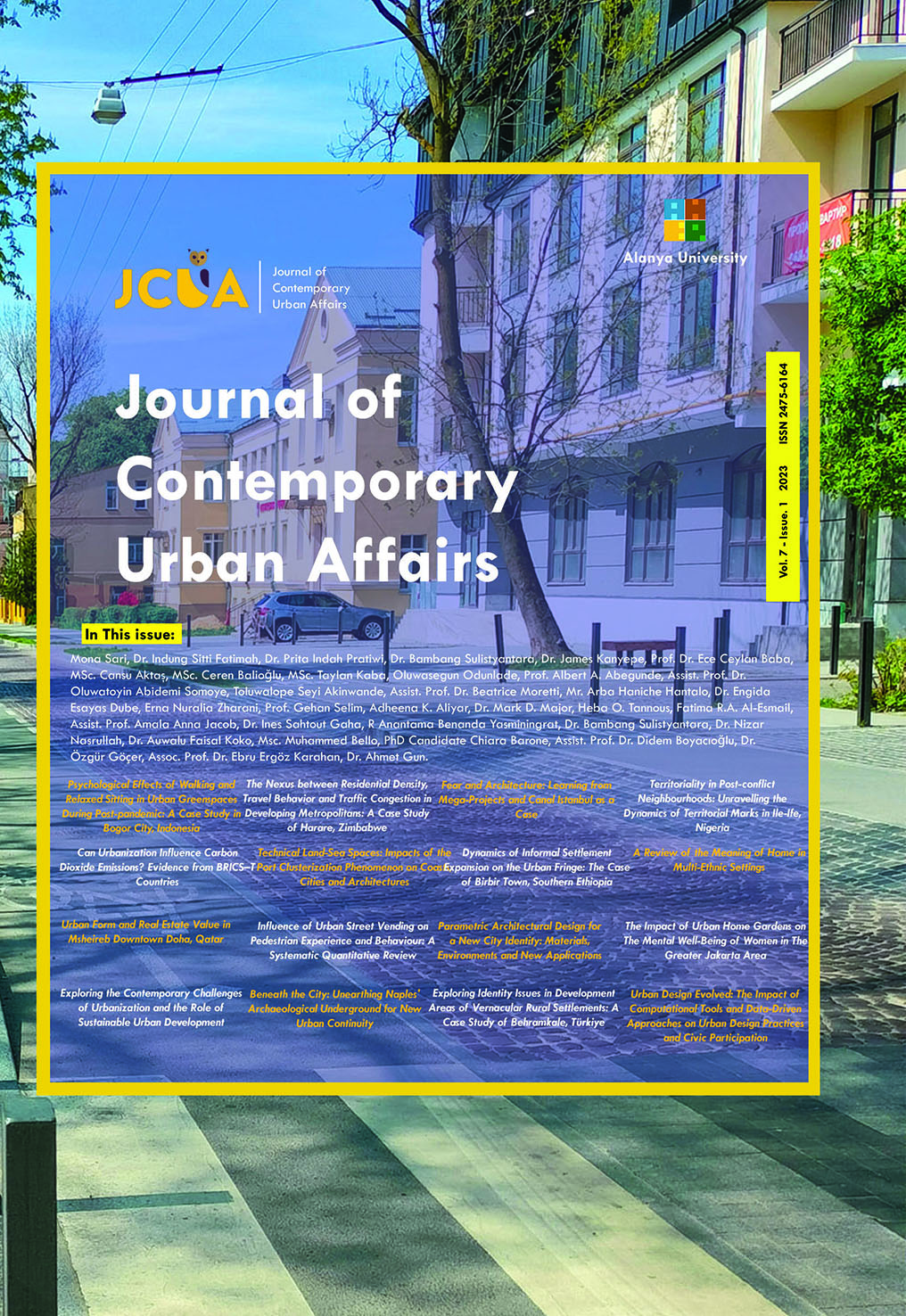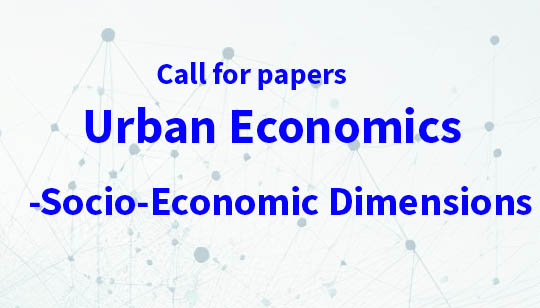Can Urbanization Influence Carbon Dioxide Emissions? Evidence from BRICS–T Countries
DOI:
https://doi.org/10.25034/ijcua.2023.v7n1-11Keywords:
Urbanization, Energy Intensity, Economic Growth, Pooled OLS, Fixed EffectAbstract
Climate change is one of several issues confronting the planet today. Addressing this problem will create a safer environment for humans and other species. Thus, this study explores how the urban population (UBNP) influences carbon dioxide emissions (CO2e) levels in BRICS–T from 1990–2021 (192 observations) using Pooled OLS and Fixed Effects techniques. In addition, energy intensity (ENIT) and economic growth (GDP) are utilized as control variables. The Pooled OLS result demonstrates that UBNP growth reduces CO2e by 0.19%; a rise in ENIT levels spurs CO2e by 1.10%, and an increase in GDP enhances CO2e by 0.61%. The Fixed Effects outcome shows that an upsurge in UBNP reduces CO2e by 1.19%, while ENIT and GDP rise boosts CO2e by 1.19% and 1.04%, respectively. This study recommends continuous urban planning, rural area development, renewable energy integration, and the use ofenergy–efficient buildings.
Downloads
References
Abban, O. J., Wu, J., & Mensah, I. A. (2020). Analysis on the nexus amid CO2 emissions, energy intensity, economic growth, and foreign direct investment in Belt and Road economies: does the level of income matter? Environmental Science and Pollution Research, 27(10). https://doi.org/10.1007/s11356-020-07685-9
Adebayo, T. S. (2023). Assessing the environmental sustainability corridor: linking oil consumption, hydro energy consumption, and ecological footprint in Turkey. Environmental Science and Pollution Research, 30(7). https://doi.org/10.1007/s11356-022-23455-1
Adebayo, T. S., Udemba, E. N., Ahmed, Z., & Kirikkaleli, D. (2021). Determinants of consumption-based carbon emissions in Chile: an application of non-linear ARDL. Environmental Science and Pollution Research, 28(32). https://doi.org/10.1007/s11356-021-13830-9
Ali, R., Bakhsh, K., & Yasin, M. A. (2019). Impact of urbanization on CO2 emissions in emerging economy: Evidence from Pakistan. Sustainable Cities and Society, 48. https://doi.org/10.1016/j.scs.2019.101553
Amin, N., & Song, H. (2023). The role of renewable, non-renewable energy consumption, trade, economic growth, and urbanization in achieving carbon neutrality: A comparative study for South and East Asian countries. Environmental Science and Pollution Research, 30(5). https://doi.org/10.1007/s11356-022-22973-2
Ayhan, F., Kartal, M. T., Kılıç Depren, S., & Depren, Ö. (2023). Asymmetric effect of economic policy uncertainty, political stability, energy consumption, and economic growth on CO2 emissions: evidence from G-7 countries. Environmental Science and Pollution Research, 30(16). https://doi.org/10.1007/s11356-023-25665-7
Balsalobre-Lorente, D., Driha, O. M., Halkos, G., & Mishra, S. (2022). Influence of growth and urbanization on CO2 emissions: The moderating effect of foreign direct investment on energy use in BRICS. Sustainable Development, 30(1). https://doi.org/10.1002/sd.2240
Bekhet, H. A., & Othman, N. S. (2017). Impact of urbanization growth on Malaysia CO2 emissions: Evidence from the dynamic relationship. Journal of Cleaner Production, 154. https://doi.org/10.1016/j.jclepro.2017.03.174
Cetin, M., Ecevit, E., & Yucel, A. G. (2018). The impact of economic growth, energy consumption, trade openness, and financial development on carbon emissions: empirical evidence from Turkey. Environmental Science and Pollution Research, 25(36). https://doi.org/10.1007/s11356-018-3526-5
Chandra Voumik, L., & Sultana, T. (2022). Impact of urbanization, industrialization, electrification and renewable energy on the environment in BRICS: fresh evidence from novel CS-ARDL model. Heliyon, 8(11). https://doi.org/10.1016/j.heliyon.2022.e11457
Cheng, Z., & Hu, X. (2023). The effects of urbanization and urban sprawl on CO2 emissions in China. Environment, Development and Sustainability, 25(2). https://doi.org/10.1007/s10668-022-02123-x
Chen, H., Tackie, E. A., Ahakwa, I., Musah, M., Salakpi, A., Alfred, M., & Atingabili, S. (2022). Does energy consumption, economic growth, urbanization, and population growth influence carbon emissions in the BRICS? Evidence from panel models robust to cross-sectional dependence and slope heterogeneity. Environmental Science and Pollution Research, 29(25). https://doi.org/10.1007/s11356-021-17671-4
Chen, W., Alharthi, M., Zhang, J., & Khan, I. (2023). The need for energy efficiency and economic prosperity in a sustainable environment. Gondwana Research. https://doi.org/10.1016/j.gr.2023.03.025
Danish, Ulucak, R., & Khan, S. U. D. (2020). Determinants of the ecological footprint: Role of renewable energy, natural resources, and urbanization. Sustainable Cities and Society, 54. https://doi.org/10.1016/j.scs.2019.101996
Dutta, U. P., & Hazarika, N. (2023). Urbanization and carbon emissions: Panel evidence from 68 low-income and lower-middle-income countries. Journal of Urban Affairs, 1–20. https://doi.org/10.1080/07352166.2023.2174871
Energy Institute. (2023). Energy Charting Tool. https://www.energyinst.org/statistical-review/energy-charting-tool/energy-charting-tool
Grossman, G., & Krueger, A. (1991). Environmental Impacts of a North American Free Trade Agreement. https://doi.org/10.3386/w3914
Harbaugh, W. T., Levinson, A., & Wilson, D. M. (2002). Reexamining the empirical evidence for an environmental Kuznets curve. In Review of Economics and Statistics (Vol. 84, Issue 3). https://doi.org/10.1162/003465302320259538
Hodžić, S., Šikić, T. F., & Dogan, E. (2023). Green environment in the EU countries: The role of financial inclusion, natural resources and energy intensity. Resources Policy, 82. https://doi.org/10.1016/j.resourpol.2023.103476
Hussain, M. N., Li, Z., & Sattar, A. (2022). Effects of urbanization and nonrenewable energy on carbon emission in Africa. Environmental Science and Pollution Research, 29(17). https://doi.org/10.1007/s11356-021-17738-2
IEA. (2022). SDG7: Data and Projections. https://www.iea.org/reports/sdg7-data-and-projections/energy-intensity
Islam, S., & Rahaman, S. H. (2023). The asymmetric effect of ICT on CO2 emissions in the context of an EKC framework in GCC countries: the role of energy consumption, energy intensity, trade, and financial development. Environmental Science and Pollution Research. https://doi.org/10.1007/s11356-023-27590-1
Karaaslan, A., & Çamkaya, S. (2022). The relationship between CO2 emissions, economic growth, health expenditure, and renewable and non-renewable energy consumption: Empirical evidence from Turkey. Renewable Energy, 190. https://doi.org/10.1016/j.renene.2022.03.139
Khan, M. (2019). Does macroeconomic instability cause environmental pollution? The case of Pakistan economy. Environmental Science and Pollution Research. https://doi.org/10.1007/s11356-019-04804-z
Khan, M. K., Babar, S. F., Oryani, B., Dagar, V., Rehman, A., Zakari, A., & Khan, M. O. (2022). Role of financial development, environmental-related technologies, research and development, energy intensity, natural resource depletion, and temperature in sustainable environment in Canada. Environmental Science and Pollution Research, 29(1). https://doi.org/10.1007/s11356-021-15421-0
Khan, Y., & Liu, F. (2023). Consumption of energy from conventional sources a challenge to the green environment: evaluating the role of energy imports, and energy intensity in Australia. Environmental Science and Pollution Research, 30(9). https://doi.org/10.1007/s11356-022-23750-x
Koilakou, E., Hatzigeorgiou, E., & Bithas, K. (2023). Carbon and energy intensity of the USA and Germany. A LMDI decomposition approach and decoupling analysis. Environmental Science and Pollution Research, 30(5). https://doi.org/10.1007/s11356-022-22978-x
Lee, C. C., Zhou, B., Yang, T. Y., Yu, C. H., & Zhao, J. (2023). The Impact of Urbanization on CO2 Emissions in China: The Key Role of Foreign Direct Investment. Emerging Markets Finance and Trade, 59(2). https://doi.org/10.1080/1540496X.2022.2106843
Liu, H., Wong, W. K., The Cong, P., Nassani, A. A., Haffar, M., & Abu-Rumman, A. (2023a). Linkage among Urbanization, energy Consumption, economic growth and carbon Emissions. Panel data analysis for China using ARDL model. Fuel, 332. https://doi.org/10.1016/j.fuel.2022.126122
Liu, F., Khan, Y., & Marie, M. (2023b). Carbon neutrality challenges in Belt and Road countries: what factors can contribute to CO2 emissions mitigation? Environmental Science and Pollution Research, 30(6). https://doi.org/10.1007/s11356-022-22983-0
Namahoro, J. P., Wu, Q., Zhou, N., & Xue, S. (2021). Impact of energy intensity, renewable energy, and economic growth on CO2 emissions: Evidence from Africa across regions and income levels. Renewable and Sustainable Energy Reviews, 147. https://doi.org/10.1016/j.rser.2021.111233
Narayan, P. K., Saboori, B., & Soleymani, A. (2016). Economic growth and carbon emissions. Economic Modelling, 53, 388–397. https://doi.org/10.1016/J.ECONMOD.2015.10.027
Naseem, S., Hu, X., Shi, J., Mohsin, M., & Jamil, K. (2023). Exploring the optical impact of information communication technology and economic growth on CO2 emission in BRICS countries. Optik, 273. https://doi.org/10.1016/j.ijleo.2022.170339
Pesaran, M. H. (2007). A simple panel unit root test in the presence of cross-section dependence. Journal of Applied Econometrics, 22(2). https://doi.org/10.1002/jae.951
Raihan, A. (2023). The dynamic nexus between economic growth, renewable energy use, urbanization, industrialization, tourism, agricultural productivity, forest area, and carbon dioxide emissions in the Philippines. Energy Nexus, 9. https://doi.org/10.1016/j.nexus.2023.100180
Raihan, A., Muhtasim, D. A., Farhana, S., Rahman, M., Hasan, M. A. U., Paul, A., & Faruk, O. (2023). Dynamic Linkages between Environmental Factors and Carbon Emissions in Thailand. Environmental Processes, 10(1). https://doi.org/10.1007/s40710-023-00618-x
Sadorsky, P. (2014). The effect of urbanization on CO2 emissions in emerging economies. Energy Economics, 41. https://doi.org/10.1016/j.eneco.2013.11.007
Salahuddin, M., Gow, J., Ali, M. I., Hossain, M. R., Al-Azami, K. S., Akbar, D., & Gedikli, A. (2019). Urbanization-globalization-CO2 emissions nexus revisited: empirical evidence from South Africa. Heliyon, 5(6). https://doi.org/10.1016/j.heliyon.2019.e01974
Shen, L., Shuai, C., Jiao, L., Tan, Y., & Song, X. (2017). Dynamic sustainability performance during urbanization process between BRICS countries. Habitat International, 60. https://doi.org/10.1016/j.habitatint.2016.12.004
Shokoohi, Z., Dehbidi, N. K., & Tarazkar, M. H. (2022). Energy intensity, economic growth and environmental quality in populous Middle East countries. Energy, 239. https://doi.org/10.1016/j.energy.2021.122164
Sikder, M., Wang, C., Yao, X., Huai, X., Wu, L., KwameYeboah, F., Wood, J., Zhao, Y., & Dou, X. (2022). The integrated impact of GDP growth, industrialization, energy use, and urbanization on CO2 emissions in developing countries: Evidence from the panel ARDL approach. Science of the Total Environment, 837. https://doi.org/10.1016/j.scitotenv.2022.155795
Somoye, O. A., Ozdeser, H., & Seraj, M. (2022). Modeling the determinants of renewable energy consumption in Nigeria: Evidence from Autoregressive Distributed Lagged in error correction approach. Renewable Energy, 190. https://doi.org/10.1016/j.renene.2022.03.143
Somoye, O. A., Ozdeser, H., Seraj, M., & Turuc, F. (2023). The determinants of CO2 emissions in Brazil: The application of the STIRPAT model. Energy Sources, Part A: Recovery, Utilization, and Environmental Effects, 45(4), 10843–10854. https://doi.org/10.1080/15567036.2023.2251921
Sreenu, N. (2022). Impact of FDI, crude oil price and economic growth on CO2 emission in India: - symmetric and asymmetric analysis through ARDL and non -linear ARDL approach. In Environmental Science and Pollution Research (Vol. 29, Issue 28). https://doi.org/10.1007/s11356-022-19597-x
Suhrab, M., Soomro, J. A., Ullah, S., & Chavara, J. (2023). The effect of gross domestic product, urbanization, trade openness, financial development, and renewable energy on CO2 emission. Environmental Science and Pollution Research, 30(9). https://doi.org/10.1007/s11356-022-23761-8
The World Bank. (2022). Key Highlights: Country Climate and Development Report for Turkey. https://www.worldbank.org/en/country/turkey/brief/key-highlights-country-climate-and-development-report-for-turkiye
Ullah, S., Luo, R., Adebayo, T. S., & Kartal, M. T. (2023). Paving the ways toward sustainable development: the asymmetric effect of economic complexity, renewable electricity, and foreign direct investment on the environmental sustainability in BRICS-T. Environment, Development and Sustainability. https://doi.org/10.1007/s10668-023-03085-4
United Nations. (2023). Causes and Effects of Climate Change. https://www.un.org/en/climatechange/science/causes-effects-climate-change
World Bank. (2023). World Bank Open Data. https://data.worldbank.org/
Xue, P., Liu, J., Liu, B., & Zhu, C. (2023). Impact of Urbanisation on the Spatial and Temporal Evolution of Carbon Emissions and the Potential for Emission Reduction in a Dual-Carbon Reduction Context. Sustainability, 15(6). https://doi.org/10.3390/su15064715
Yang, Z., Cai, J., Lu, Y., & Zhang, B. (2022). The Impact of Economic Growth, Industrial Transition, and Energy Intensity on Carbon Dioxide Emissions in China. Sustainability (Switzerland), 14(9). https://doi.org/10.3390/su14094884
Zhang, X., Shi, X., Khan, Y., Khan, M., Naz, S., Hassan, T., Wu, C., & Rahman, T. (2023). The Impact of Energy Intensity, Energy Productivity and Natural Resource Rents on Carbon Emissions in Morocco. Sustainability (Switzerland), 15(8). https://doi.org/10.3390/su15086720
Published
Issue
Section
License
Copyright (c) 2023 Assist. Prof. Dr. Oluwatoyin Abidemi Somoye , Toluwalope Seyi Akinwande

This work is licensed under a Creative Commons Attribution 4.0 International License.






















